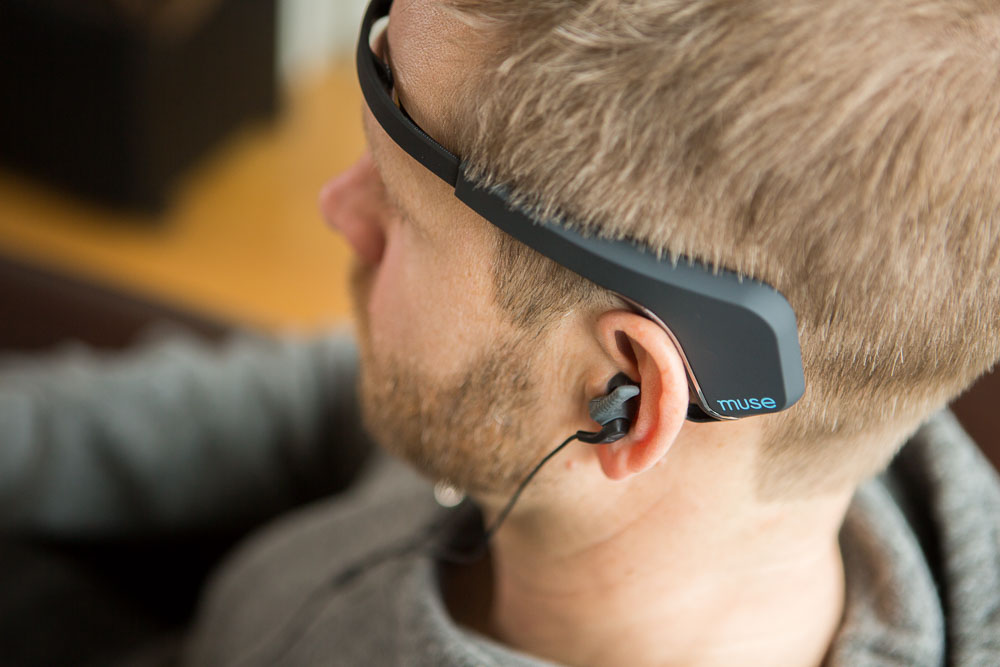If you already understand what Muse is all about, and is only interested in getting an exclusive 15% discount, scroll to the bottom of this article.
(Update: Learn more about Muse 2 and discount link at the bottom of the article)
In recent years, technology has made meditation accessible and easy for the public. With popular meditation apps vying for the attention of new meditators, I wondered what’s the next innovation that will take meditating to a whole new level.
The sight of Muse, a brain sensing headband definitely caught my attention as an electronics engineer with prior meditation experience. Judging by its mere visual, it’s easy to mistaken muse for some sophisticated VR gears.
Muse, with its sleek futuristic design and brain sensing capability, would impress any technology geeks and medical researchers. However, I was initially skeptical of how a piece of sensors-loaded headband could improve meditation experience.
Meditation In A Nutshell
Meditation, or to be specific, mindfulness meditation has nothing to do about getting rid of negative thoughts. Instead, it is about grounding your thoughts in the present and remain unaffected by regrets, worries, or other negative emotions.
Traditionally meditation was practiced in the context of eastern religion, but meditation has gained popularity in its secular in the West, thanks to pioneers like Jon Kabat Zinn. Scientists have also added weight to the benefits of meditation with a series of published research.
I usually discourage beginners to pick up meditation on their own, especially when they are stressed out to start with. The reason is, they could end up trapped in negative thoughts and wonder why meditation aggravates their mental anguish.
Some practitioners may be skeptical about blending technologies and the ancient practice of meditation. But I’ve found meditation apps to be as helpful as guided instruction for beginners. That gave me the reason to look to conduct a private study on the Muse, to find out if it adds any value to meditation practice.
Muse, The Brain-Sensing Headband
The Muse is a sleek and lightweight headband that looks futuristic and is actually equipped with advanced technology uncommon to regular consumer electronics.
Its primary function is to acquire the brain signal of humans and it does so with 7 sensors that are fitted along the inner part of the headband. 5 of the sensors are positioned at the forehead while the remaining two are meant to be placed at the back of the ear.
Embedded in this slim headband is a Bluetooth module, that enables connectivity with its meditation app. The Muse operates wirelessly, which means it depends on an internal battery that can be charged via a micro USB cable. A series of LED indicators alert users of its charging state or if it is paired successfully with the app.
Muse, The Science Behind
I can’t help but marvel at the technology that fits the EEG sensors at the headband. But a glance at the team that brought Muse to life gives a great picture of the level of expertise it possesses.
Muse was designed by InteraXon, a company specializing in brain-sensing technology. With its past projects like a brain-powered beer tap and remote controlling the lights at Niagara falls 2,000 miles away, you’ll get the picture of the level of technology that brought Muse to life.
The Muse is designed to take advantage of EEG, or electroencephalography at its core. It is a technology that is used in hospitals to obtain electrical signals reading from the brain. The readings from EEG helps to support the diagnosis of patients with brain disorders, like Alzheimer and epilepsy.
While Muse gained popularity as a meditation headband, it has been used by researchers to aid in their studies and research. The fact that Muse headbands are used by top neuroscientists made this meditation headband even more impressive.
The Muse App

The app has a modern and appealing interface with the contents neatly visualized in a clear manner. You won’t be overwhelmed by a great number of pages or buttons. The options are divided into Me, Session and Setting.
Prior to starting your first session, you’ll be prompted to choose the right model of the headband. The app displays the distinguished model images and characteristics to ensure you make no mistake in this step.
You’ll only need to perform the Bluetooth pairing process only once as the app is intelligent enough to automatically connect to the headband the next time it was launched.
Muse provides several Soundscapes or the environmental background audio that accompanies the meditation instruction. You can choose your favorite Soundscapes from the Rainforest, Beach, Desert and City Park.
Here’s where the similarity of Muse and other meditation apps ends. With the Muse headband connected, the app will be able to analyze the state of your mind and changes the background sound accordingly. A calm mind results in the calm wind in the audio while an agitated mind causes the audio to project the sound of strong wind.
The brainwave captured by the Muse headband does more than altering the audio to reflect the mental state. The data are stored in the app and reflected in graphical form. You’ll be able to recollect your meditation and notice how your mind fluctuates throughout the session.
Meditation is a personal journey and it’s easy to lose motivation and direction to meditate. The Muse app features suggestions, milestones, challenges, and achievements to help you to meditate consistently.
It’s important that you do not share the apps with others as each individuals brain wave data is unique. You do not want to risk jumbling up the data on your app. Meanwhile, sharing the Muse headband is alright.
How Muse Works To Enhance Meditation Experience
Can you meditate without the Muse headband? The honest answer is yes. After all, meditation practitioners have been doing so for thousands of years without any app or futuristic devices.
With that said, I strongly believe that the Muse headband can help new meditation practitioners or regular meditators who struggled to focus on their breathing.
When meditating in a religious context, it is often advised that allowing the mind to wander, and gently returning it back to breathing is one of the key training for mindfulness and discovering the true nature of existence.
However, people who take up secular mindfulness meditation may struggle with focusing and having their mind wander to no ends during meditation. For some, this can be pretty discouraging, as they are less likely to experience the blissful experience when the mind is focused and calm.
I’m not saying that using Muse will enable deep meditation experience immediately. But with Muse, the changing sound that reflects your mental state can help you to guide your mind back to breathing more efficiently. You spend less time losing yourself in thoughts and more on observing your breath.
Should You Use Muse For Meditation
The Muse headband is a sophisticated device. The reliability of Muse in detecting the brain wave accurately depends on the aligning the sensor correctly. This means adjusting the headband until all 7 sensors are in contact of your forehead.
Even with that, humans minds and thoughts can be unpredictable, even for Muse itself. There are occasions where the Muse simply does not reacts when meditation practitioners wandered from their focus. Of course, this doesn’t necessarily mean the hardware is flawed, but rather the app may need further fine-tuning in the future.
But merely highlighting the negative feedbacks doesn’t do justice for Muse. Do bear in mind that the headband has been used by top neuroscientists. The Muse team definitely know what they are building.
To be fair, the positive feedbacks greatly outweigh the negatives. It does help meditators to be more focus and calm in their practice. Besides that, the readings that point to a distracted state of mind is accurate most of the time.
Can you meditate deeply without Muse? Yes. But that’s also asking if it’s possible to work out without getting a Fitbit. Devices like Muse helps meditation practitioners become more engaged in their practice.
My Personal Take On Muse
Muse, the head sensing headband and the meditation app is a leap forward in guided meditation. It’s perfectly fine if you don’t use Muse to meditate. Eventually, you’ll still grasp the basics of meditation and experience the calmness.
However, if meditations are all about achieving calmness, Muse is akin to a shortcut you could take if you are willing to part with $149. Or you could save 15% off by ordering from this link.
Here’s a recap of the pros and cons of Muse again.
Pros
- EEG brain sensing feedback helps to reduce wandering mind.
- A fully functional meditation app that is easy to navigate.
- Extensive resources on the Muse website.
- Easy Bluetooth pairing with the headband.
Cons
- Brain sensing accuracy is not perfect.
- Premium cost.
- You can start meditating without it.
- Calibrating the headband can be a hassle.
Again, it’s entirely up to you to decide if Muse is the best meditation companion. If so, get your set of Muse from this link to enjoy a 15% discount exclusively for my readers.
Update: The New Muse 2 Released In October 2018
The team behind Muse has launched Muse 2 in October 2018. Meditation practitioners and brain sensing fans could be asking what’s the difference in this new version of meditation headband.
Of course, Muse 2 comes with a sleeker design armed with newer sensors and a soft-touch finish. While retaining the key feature of its predecessor i.e. measuring brain wave in real time, Muse 2 boasts few additional parameters.
- body movement
- heart rate
- breath
It takes the feedbacks to deliver an empowering meditation experience that is more complete than ever. You’ll be more in tune when you meditate with feedbacks from heart rate sensing. The breathing sensor helps in guiding you to beat stress with the right breathing technique.
And if you’re having trouble getting the right posture when meditating, the new body movement sensor will help. It’s essential to retain a relaxed posture not only for meditation but to make it a good habit in life.
Muse 2 is priced at $249, which is higher than its predecessor. But you can get a 15% discount by clicking through this link.
Either way, feel free to browse other meditation articles that can simplify your practice.
Related:
- Headspace Meditation App – Is It Worth $95.88 A Year
- Aware Guided Meditation App Review – Mindfulness And More
- Best Mindfulness Apps To Start Your Meditation Practice
- 22 Simple Mindfulness Meditation Tips To Simplify Your Practice
- How Long Should You Meditate To Get Real Effective Results
- Best Meditation Cushion For Mindfulness Practice








Leave A Comment